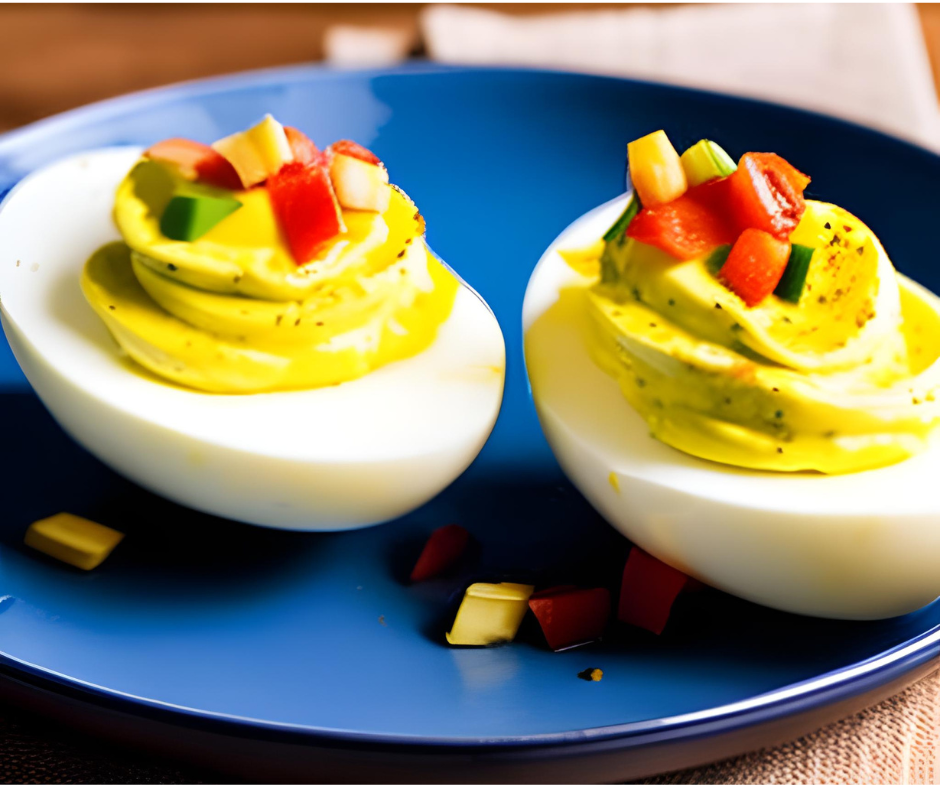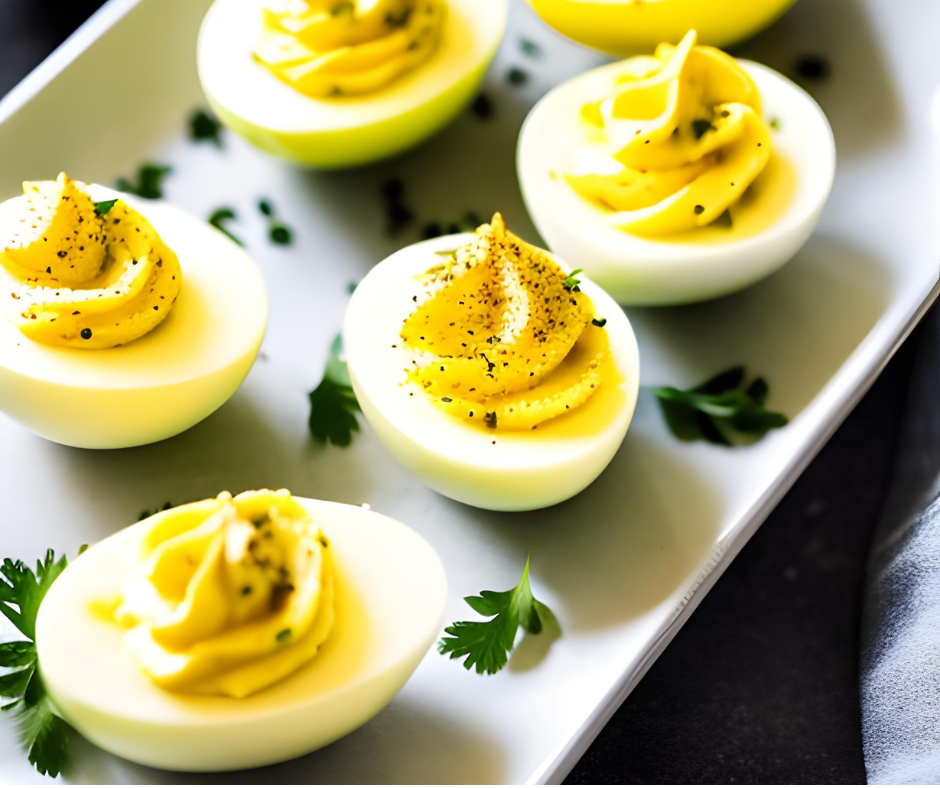
Deviled eggs, with their creamy and flavorful filling nestled within a halved hard-boiled egg, are a popular and delectable appetizer or snack. However, as with any perishable food item, it’s essential to prioritize food safety and be able to know when deviled eggs have gone bad. The last thing you want is to consume spoiled deviled eggs and risk an unpleasant dining experience or even foodborne illness. In this blog post, our aim is to provide you with clear signs of spoilage in deviled eggs, equipping you with the knowledge to confidently discern whether your deviled eggs are still fresh or have crossed the line. So, let’s delve into the topic and unravel the secrets of determining if your deviled eggs are past their prime.
Understanding Deviled Eggs
Deviled eggs consist of several key components that come together to create their unique flavor and texture. Let’s break down the basic components:
- Hard-boiled eggs: Deviled eggs start with perfectly boiled eggs, which are cooked until the yolks are firm and fully set. These eggs serve as the base for the creamy filling and are essential to achieving the classic deviled egg presentation.
- Mayo: Mayonnaise is a key ingredient in the filling of deviled eggs. It adds richness and creaminess, binding the other ingredients together. Mayo provides a smooth texture and contributes to the indulgent taste of deviled eggs.
- Mustard: Mustard brings a tangy and slightly pungent flavor to deviled eggs. It adds a delightful kick and enhances the overall taste of the filling. The type of mustard used can vary, including options like Dijon mustard, yellow mustard, or even spicy mustard for those who enjoy a bit of heat.
- Seasonings: Various seasonings are often added to the deviled egg filling to enhance the taste profile. Common seasonings include salt, black pepper, paprika, garlic powder, onion powder, or fresh herbs like chives or parsley. These seasonings contribute depth and complexity to the flavor of deviled eggs.
It’s worth noting that while these are the fundamental components, there is room for creativity and personalization when making deviled eggs. Some variations may incorporate additional ingredients such as vinegar, Worcestershire sauce, hot sauce, relish, diced pickles, or finely chopped onions. These additions can add unique flavors and textures, allowing you to put your own spin on this classic appetizer.
Also interesting to read:How Long To Air Fry Chicken Sausage : From Sizzle to Perfection
Important:
Additionally, it is important to recognize that deviled eggs, like any dish containing perishable ingredients, have a limited shelf life. The combination of eggs and mayonnaise makes deviled eggs prone to bacterial growth if not handled and stored properly. To ensure their freshness and safety, it’s crucial to store deviled eggs in the refrigerator and consume them within a reasonable time frame. Proper storage and handling practices help preserve the quality of deviled eggs and minimize the risk of foodborne illnesses.
Signs of Fresh Deviled Eggs

Fresh deviled eggs possess distinct characteristics that indicate their quality. Let’s explore these signs:
- Appearance: When deviled eggs are fresh, their filling exhibits a smooth and creamy consistency, evenly spread within the egg white halves. The color of the filling should be consistent throughout, without any discoloration or unusual spots.
- Aroma: Fresh deviled eggs emit a mild and pleasant scent. The aroma should not be overpowering or give off any off-putting odors, indicating that the ingredients used are fresh and harmoniously blended.
- Texture: Fresh deviled eggs have a delightful texture that is firm yet creamy. The filling should be smooth and velvety, without any signs of being slimy, runny, or separated. It should hold its shape when cut or bitten into, offering a satisfying mouthfeel.
By paying attention to these three key indicators—appearance, aroma, and texture—you can quickly determine if your deviled eggs are fresh and ready to be enjoyed.
Common Signs of Spoiled Deviled Eggs
To ensure your safety and enjoyment, it’s crucial to be aware of the signs that indicate deviled eggs may have gone bad. Look out for the following indicators:
- Appearance: If deviled eggs have spoiled, you may notice changes in their appearance. The filling may develop a greenish or grayish tinge, which indicates the growth of harmful bacteria. Additionally, the filling might appear dry or cracked, suggesting a loss of moisture and potential spoilage.
- Aroma: This is the fastest way to know if deviled eggs are bad. In this case, spoiled deviled eggs emit a distinct sour or off-putting smell. If you detect an unpleasant odor when you open the container or take a whiff, it’s a clear sign that the deviled eggs have spoiled and should be discarded.
- Texture: The texture of spoiled deviled eggs undergoes noticeable changes. The filling may become slimy, indicating bacterial growth and decomposition. Similarly, if the filling appears excessively watery or has a runny consistency, it’s an indication that the deviled eggs have become unfit for consumption. Additionally, an overly soft or mushy texture is a sign of spoilage.
- Taste: When deviled eggs have gone bad, they often develop an unusual or unpleasant taste. If you take a bite and notice a sour, rancid, or generally off taste, it’s a clear indication that the eggs have spoiled, and consuming them could lead to foodborne illness.
If you want to know if your deviled eggs are bad, observe any of these signs of spoilage —changes in appearance, a sour smell, slimy or watery texture, or an unpleasant taste—it is best to err on the side of caution and discard the eggs to avoid potential health risks. Remember, your safety and well-being are paramount.
People also read:How Long Does Cheesecake Last in the Fridge?
Factors Affecting Deviled Eggs’ Shelf Life

Several factors can significantly influence the shelf life of deviled eggs. Understanding these factors is crucial for maintaining the freshness and safety of your deviled eggs. Let’s explore them:
Temperature:
The temperature at which deviled eggs are stored plays a vital role in their shelf life. Storing deviled eggs at room temperature allows bacteria to multiply rapidly, increasing the risk of spoilage and foodborne illnesses. It is essential to refrigerate deviled eggs promptly after preparation and keep them refrigerated until ready to serve. The cold temperature of the refrigerator helps slow down bacterial growth and extends the shelf life of deviled eggs.
Storage Duration:
Deviled eggs are best consumed within a specific timeframe to ensure their quality and safety. While the exact duration can vary based on factors such as ingredient freshness and storage conditions, it is generally recommended to consume deviled eggs within 2-3 days of preparation. Beyond this timeframe, the risk of bacterial growth and spoilage increases significantly. To enjoy deviled eggs at their best, it’s advisable to make them in smaller batches and consume them within the recommended storage duration.
Quality of Ingredients:
The freshness and quality of the ingredients used in deviled eggs can impact their shelf life. Start with fresh eggs that are within their expiration date. Using eggs that are already nearing their expiration can decrease the overall shelf life of the deviled eggs. Additionally, using fresh mayonnaise and other ingredients that have been stored properly and are not past their expiration dates contributes to the longevity of the deviled eggs.
By considering these factors—temperature, storage duration, and ingredient quality—you can maximize the shelf life of your deviled eggs and ensure that they remain safe and enjoyable to consume. Proper storage in the refrigerator, consuming them within a recommended timeframe, and using fresh ingredients are key to preserving the quality and minimizing the risk of spoilage.
Proper Storage and Handling Tips for Deviled Eggs
To maximize the freshness and safety of your deviled eggs, it’s essential to follow proper storage and handling practices. Here are several practical tips to remember:
I. Refrigeration:
Deviled eggs should always be stored in the refrigerator. Bacteria grow rapidly at room temperature, so it’s crucial to refrigerate deviled eggs promptly after preparation. Place them in a covered container and ensure they are stored at a temperature of 40°F (4°C) or below. Refrigeration helps slow down bacterial growth and preserves the quality of the deviled eggs.
II. Covered Containers:
When storing deviled eggs in the refrigerator, use airtight or tightly covered containers. This helps prevent any odors from other foods in the refrigerator from being absorbed and maintains the freshness of the deviled eggs. It also protects the deviled eggs from any potential contamination.
III. Storage Duration:
Deviled eggs are best consumed within 2-3 days of preparation to ensure their freshness and safety. As time passes, the quality of deviled eggs can deteriorate, and the risk of bacterial growth increases. It’s important to keep track of the storage duration and prioritize consuming the deviled eggs within the recommended timeframe.
By following these storage and handling tips—refrigerating deviled eggs, using covered containers, and consuming them within the recommended duration—you can extend the freshness and ensure the safety of your deviled eggs. These practices help maintain their taste, texture, and overall quality, allowing you to enjoy this delightful appetizer without any concerns regarding how to know if deviled eggs are bad.
Discover: How Long Does Pimento Cheese Last
When in Doubt, Discard:

When it comes to the safety of deviled eggs or any perishable food item, it’s crucial to trust your senses and use common sense to know if deviled eggs are bad. If you have any doubts or suspicions about the freshness or safety of your deviled eggs, it’s always better to err on the side of caution. Here’s why:
A. Trusting Your Senses:
Your senses of sight, smell, and taste are powerful tools for how to know if deviled eggs are bad as well as evaluating the condition of food. If your deviled eggs exhibit unusual changes in appearance, such as discoloration, dryness, or cracks in the filling, it’s a sign that something might be amiss. Likewise, if you detect an off-putting or sour odor when you open the container, it’s a strong indication of spoilage. Trusting your senses can help you identify potential risks and make informed decisions about the safety of your deviled eggs.
B. Using Common Sense:
Common sense plays a crucial role in food safety. If your deviled eggs have been left out at room temperature for an extended period, exposed to high temperatures, or stored for an excessive duration, the risk of bacterial growth and spoilage increases. In such situations, it’s best to exercise caution and discard the deviled eggs to prevent any potential health risks. Common sense prompts us to prioritize our well-being and make choices that minimize the chances of foodborne illness.
C. Err on the Side of Caution:
If you have any doubts or concerns about the quality or safety of your deviled eggs, it’s recommended to discard them. Consuming spoiled food can lead to food poisoning, which can cause severe illness and complications. By erring on the side of caution and discarding suspicious deviled eggs, you protect yourself and those you serve from potential harm.
Remember, your health and well-being are paramount. If you are wondering whether your deviled eggs are bad or you have any doubts, trust your senses, use common sense, and prioritize food safety. When in doubt, it’s best to discard deviled eggs that appear or smell suspicious. By doing so, you ensure a pleasant and risk-free dining experience.
Conclusion
Ensuring the freshness and safety of deviled eggs is essential for a delightful dining experience. By understanding the signs of freshness and spoilage, storing them properly, and trusting our senses, we can confidently enjoy this beloved appetizer without compromising our well-being. Remember, when in doubt, discard any deviled eggs that appear or smell suspicious. Let’s prioritize food safety and savor the goodness of perfectly made deviled eggs.
Also read: How to Layer Lasagna :Learn How To Do It Like A Pro
